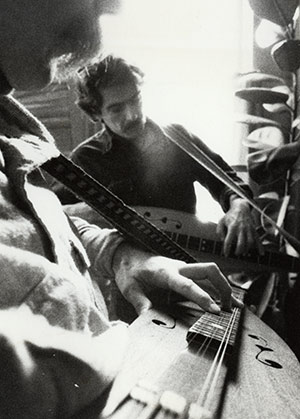Hollow Log
Author: Robert Force
Date/Studio: 2013 Synergy, Port Townsend, WA
Engineer: Neville Pearsall
Producer: Robert Force
Original Release: Did You (BSR151)
Current Release: Did You (BSR151)
 “Let's play a little holler log.” With that statement Albert and I would launch into an impromptu, lick-trading melody cast in an Appalachian mountain music manner. Traditional music leans heavily on 4/4 timing, the fifth (sol), the seventh (ti) or second (re) for tension, pushes up to the octave and resolves back to the root (do). It is what the British folk historian, Cecil Sharp, (1859-1924) meant when he said, “Unless corrupted by an outside influence, the taste of the people is impeccable.” Folk melodies are constantly being reinvented around these simple rules because they make easy, musical sense.
“Let's play a little holler log.” With that statement Albert and I would launch into an impromptu, lick-trading melody cast in an Appalachian mountain music manner. Traditional music leans heavily on 4/4 timing, the fifth (sol), the seventh (ti) or second (re) for tension, pushes up to the octave and resolves back to the root (do). It is what the British folk historian, Cecil Sharp, (1859-1924) meant when he said, “Unless corrupted by an outside influence, the taste of the people is impeccable.” Folk melodies are constantly being reinvented around these simple rules because they make easy, musical sense.
Al and I would punctuate many performances with the fun liberty of just trading licks. No two of these adventures were ever the same. The Hollow Log tune on the Did You cd is one of this type. I was sitting in the recording booth and said to Neville, the engineer, “I'm just going to do an Appalachian run-around and see what happens.” I experimented for a couple of minutes with a few themes and an idea of how to proceed began to shape. It's not enough just to “noodle,” a tune needs form.
The intro does just that-- it sets up a simple, conversational melody with a bouncy back beat using the “walking the string” exercise I descibe in Wabash Canonball. The second note of the scale (re) is used for tension. That's the place where the music pauses (like in a conversation) to gather a few heartbeats of time. All of this is in “first position”, the hand never moves, the fingers can only reach out through the bottom half of the first octave.
Next I use a two-stop, cut-time “shout out” that is loosely lifted from Shortnen' Bread to set up the square box of the tune. Like a call and response gospel song, I punctuate the “blocky” cut-time chords with the theme being set up on the bass. Having laid a foundation, I jump into hot licks starting on the treble strings. In this kind of “lead” work the goal is to build up to the octave “turn-around” in such a way that everyone already knows where it is going and is just listening to see how it is you are going to get there. It is an exquisite exercise in dexterity and timing.
After reestablishing the melody, I go for a lead line on the bass. I DO have so much fun with that string! Being positioned away from my body means I can work more with slight bending. The first time this was evident in the maturing of my music was in the lead I played on Albert' tune, St. Elmo's Fire. Although that song is in a minor, the same structure that I am now describing was being used.
The middle string is seldom played as a lead line by most dulcimer players. It has a lesser volume voice and it is hard to be clean reaching between the other stringss. Ah, but the tone..! I go for it for the third “solo.” The trick is to lay back from the strumming so the other strings don't overwhelm the middle. By shortening the strum stroke the pick articulation is concentrated and the string can ring out.
Back to the theme and the call and response, back to one final lead on the bass (because it is so much fun) and the tune is looking for a close. That is accomplished by filling in the rest of the Shortnen' Bread double-stop chords by letting them state the rest of the closing phrase instead of just the opening teaser. By now the tune is moseying along with the simple 3-2-1, ba-ba-bah, burbling in the brain.
Hands in my metaphorical musical pockets, grass stem in my mouth, straw hat tipped for the sun, the tune ends with a big harmonic. But I can't let go, so I noodle off like ambling down a dusty road. Oh, this all seems like it is made up for the fun of using language but this feeling is exactly what is was like for me summers in North Dakota after chores. I would head down the road from Uncle Ted and Aunt Martha's to the one-room schoolhouse a mile away that was always left unlocked. There I could escape the heat and read to my heart's content long as I was home for supper. Ba ba bah-- I was free.
